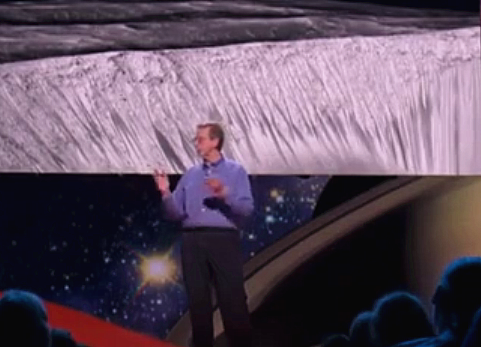(单词翻译:单击)
听力文本
A few months ago the fairy tale came true.
几个月前,童话故事成真了!
We announced to the world that we know what these streaks are. It's liquid water.
我们向世界宣布,我们已经知道这些条纹是什么了。是液态水。
These craters are weeping during the summer.
这些陨石坑在夏天浸出水分。
Liquid water is flowing down these craters.
这些液态水顺着陨石坑向下流。
So what are we going to do now -- now that we see the water?
我们接下来要做什么--在发现了液态水之后?
Well, it tells us that Mars has all the ingredients necessary for life.
这说明火星拥有生命的所有必需成分。
In its past it had perhaps two-thirds of its northern hemisphere -- there was an ocean.
在过去,可能它的北半球有三分之二都曾是海洋。
It has weeping water right now. Liquid water on its surface.
现在它有冒出的水流。星球表面有液态水。

It has organics. It has all the right conditions.
它有有机物。它有一切合适(孕育生命)的条件。
So what are we going to do next?
那么我们接下来要做什么呢?
We're going to launch a series of missions to begin that search for life on Mars.
我们将开展一系列任务,开始寻找火星上的生命。
And now it's more appealing than ever before.
现在行动要比以往任何时候都更有吸引力。
As we move out into the solar system, here's the tiny moon Enceladus.
在离地球更远的太阳系里,有一个小小的土卫二。
This is not in what we call the traditional habitable zone, this area around the sun.
它不在我们以往公认的宜居区域内,也就是靠近太阳的区域。
This is much further out. This object should be ice over a silicate core. But what did we find?
这里离太阳很远。这个星球应该像个被冰层覆盖的硅酸盐核心。但我们找到了什么?
Cassini was there since 2006,
自2006年起,卡西尼太空船就在那里,
and after a couple years looked back after it flew by Enceladus and surprised us all.
在飞过土卫二的几年后,再回过头看,我们都大吃一惊。
Enceladus is blasting sheets of water out into the solar system and sloshing back down onto the moon.
土卫二在向太阳系喷出一片片的水,再回落到它的表面。
What a fabulous environment.
多么美妙的环境啊。
演讲介绍
最新研究表明,火星或许不是唯一可能有外星生命出现的星球哦。在远离我们所认为的太阳系宜居带的系郊地区,有三颗卫星也许也在悄悄孕育着小生命。外星生命或许其实无处不在,人类或许并不孤单。


